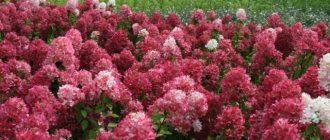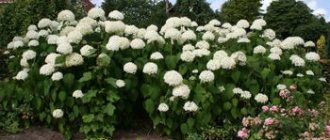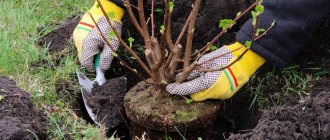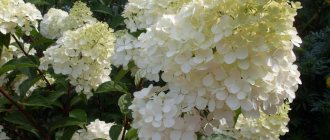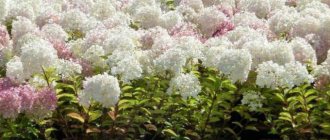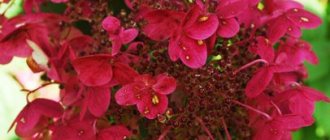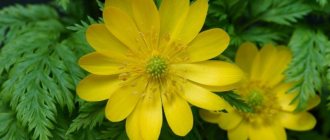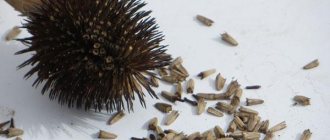- April 19, 2019
- Flowers
- Kristina Degtyareva
Paniculate hydrangeas have long gained popularity among gardeners around the world. Which is not surprising, because these shrubs look just great, and caring for them is not particularly difficult and does not take much time. The heroine of our article today is the delightful hydrangea paniculata Vanilla Fraze. Planting and care, biological description are presented below. Please note: this variety is quite in demand in the southern regions of our country, but experienced gardeners achieve excellent results even in the northern regions.
History of appearance
Vanilla Fraze was developed in France. The breeding was carried out by specialists from a nursery called Renault. The first work began back in 1989. The breeders were faced with a rather difficult task - they had to get a hydrangea that would quickly change its delicate white color to pink. As a result, several plants were obtained. But the final choice fell on Vanille Fraise hydrangea. This happened in 2003.
Flowering culture
Inflorescences are dense panicles in the form of a fluffy cone with a blunt crown, located at the ends of the current year's growth. When the shoots are normalized, they become simply huge - up to 30 cm long, with a diameter at the base of about 20 cm. If you leave the Vanilla Freeze bush to grow without pruning, a lot of flower caps will form, but their size will be significantly smaller.
The Hydrangea Vanille Fraise really does taste like a vanilla strawberry ice cream cone. Large, sterile, four-petaled flowers form a dense cap, small at first, with greenish buds. They open gradually, from bottom to top, blooming, the panicle increases until it reaches its maximum size. During flowering, this is one of the most spectacular varieties of paniculata hydrangea.
Vanilla Fraze hydrangea consistently changes color:
- At first the blossoming buds are white;
- over time, the lower flowers become strawberry in partial shade or juicy pink in the sun, the upper ones remain milky;
- by autumn there are practically no white areas on the hydrangea panicles, except perhaps a few buds at the top, but at the base the color changes to carmine;
- If faded inflorescences are not cut off, closer to winter they dry out and turn red.
In partial shade, Vanilla Fraze reaches maximum decorative value - the buds are bright, as in the photo, but slowly change color. On one panicle the entire range of colors inherent in the variety is simultaneously present.
If you plant a hydrangea in the sun, the transformation from white to crimson occurs quickly, the buds begin to age and dry out. Due to intense lighting, the pink, strawberry or carmine petals of Vanilla Fraze appear faded, much paler than the caps located in comfortable conditions.
After rain, the hydrangea bush must be shaken off. Otherwise, the drops will not only make the panicles heavy and make them bend to the ground, but they will also not evaporate for a long time, and the petals will begin to rot. This will not harm the health of the plant, but will reduce its decorative effect.
The Vanilla Fries variety blooms from July to September or October, depending on the region. Cut branches last a long time in bouquets, and dry ones are used in floristry. Flowering usually begins at 3-4 years of age.
Biological description of hydrangea Vanilla Fries and photo
This name fully justifies the color scheme of the inflorescences - a combination of white and deep pink shades. The word fraise can be translated from French as “strawberry”. So what is Hydrangea paniculata Vanilla Fraze? The description is amazing: it is a spreading shrub with powerful and elastic shoots, the height of the plant on average reaches from one and a half to two meters. The shoots have a rich burgundy hue. Along the entire length of the branches there are neat oval leaves.
Hydrangea blooms begin in June and can continue until mid-November. The inflorescences are characterized by a pyramidal shape, each about 30 centimeters long. At the same time, initially the petals are white, but closer to August, hydrangea flowers become bright pink. At the beginning of autumn, the pink tone changes to burgundy-red. The plant blooms in the first year after planting in the ground.
Application in landscape design
In landscape design, Vanilla Fraze hydrangea is used very often. Experts like the large size of their inflorescences, long flowering, and the color of the petals changing during flowering, which gives the plant additional decorativeness.
The plant is a tall plant, so hydrangea shrubs are used as the main background, planted in the background of flower beds (or in the center). And low flowers are planted in the foreground or along the edges.
These abundantly flowering perennials are also used as a hedge, planted along the perimeter of the site, near the entrance to the country house. These perennials look beautiful near gazebos or open terraces.
The beauty of Vanilla Fraze hydrangea is enhanced by coniferous shrubs and trees planted nearby.
Selection of seedlings
Have you decided to plant Vanilla Fraze hydrangea in your garden? Planting and care are very important stages, but there is something more important. This is the choice of seedling! It depends on which plant you choose how it will bloom and whether it will decorate your site. First of all, you should pay attention to the fact that seedlings on sale come with an open or closed root system. Of course, plants with bare roots are cheaper, but they take root less well. Hydrangea roots should be strong, free of damaged areas and mold.
Details
Correct choice of planting site and seedling preparation
It is best to plant Hydrangea paniculata Vanilla Fraise in lighted areas without constant exposure to direct sunlight.
If the light does not penetrate to the planting site, it is better to abandon the idea of \u200b\u200bgrowing hydrangea there. The plant can grow in the shade, but its appearance cannot in any way be called decorative. Such a flower is unlikely to decorate a garden plot.
Vanilla Fraze hydrangea seedlings are quite fragile; they can be broken even by a strong blow of wind. It is ideal to choose an area protected from drafts. It can be fenced with a fence or fruit trees.
Only healthy samples are selected for planting. Regardless of the place of purchase, it must be examined for external damage, the integrity of the root system, and the condition of the leaves and shoots must be assessed.
Optimal time to plant Vanilla Fries hydrangea
Spring is the ideal time to plant Vanilla Fraze hydrangea, but the procedure can also be planned for the fall, before frost sets in.
Interesting! Planting time directly depends on the growing region. If you plant hydrangea in the Urals or Siberia, it is better to do it in the spring. In these places there is a risk of severe frosts, and the plant may not have time to take root. In the southern parts of Russia, planting can be left until the fall, if conditions are favorable.
The planting site is also selected with an emphasis on the growing region. In the northern parts, hydrangea can be planted in sunny areas, because its activity is not as high as in the southern regions.
Rules for planting hydrangea paniculata
To plant a hydrangea bush, you need to prepare the soil. Planting is done in the following soil:
- humus 2 parts;
- leaf soil 2 parts;
- 1 part peat crumbs and the same amount of sand.
If it is impossible to prepare the soil yourself, you can buy a suitable composition in the store.
Soil in the form of a mound is poured into the prepared hole, and the roots of the Vanilla Frize hydrangea seedling are melted around it. The root collar is not buried, and after compacting the soil, the plant must be watered abundantly. The last step is to sprinkle the tree trunk circle with mulch. Peat or pine bark is used as a coating that protects against drying out. The mulch layer of these materials is almost completely overheated and thus does not allow the acidity to change.
Choosing a place in the garden
In order for Vanilla Fraze to take root on the site and delight with lush flowering for a long time, it is important not only to select seedlings, but also to choose a suitable place. A number of factors should be taken into account: lighting, the presence of other bushes or trees nearby, the presence or absence of wind protection. The ideal option for this variety of hydrangea would be shaded areas, because bright sunlight slows down the growth of the plant and the inflorescences become small.
If your garden does not have a shady area, you can plant hydrangea in the sun, but it will be important to water it frequently and abundantly. Young plants need careful protection from the wind. For such purposes, any buildings, fences or low trees are suitable. You should not plant Vanilla Fraze hydrangea under trees, which absorb all the water. In the northern regions and the middle zone, gardeners recommend planting shoots on the south side.
Care and pruning
Hydrangea Vanilla Fraise: paniculata, garden
After planting and rooting the shoot, you need to provide proper care for it. You need to know which growth conditions are most optimal for flowering.
Watering mode
The first point on how to care for a sprout is to follow the watering regime. Hydrangea is a moisture-loving plant. If it is located on the south side and the sun shines on it, then the frequency of watering is at least 2 times a week, 30-50 liters for each bush.
To prevent moisture from evaporating prematurely in summer, sawdust or rotted leaves are added around the shoots. You can tell when it’s time to water the plant again by looking at the dry soil around the bush.
Top dressing
The first year, feeding is not needed, since the shoot is planted in a nutrient medium. Next, you need mineral fertilizers (saltpeter, phosphates).
The application of fertilizing consists of several stages. The first - soon after waking up, the second - before flowering begins. This is necessary to activate the budding process. After flowering, the bush is fertilized using special products for azaleas or hydrangeas. The last stage is before wintering.
Features of care during the flowering period
During the active period, all hydrangea needs is frequent watering and no feeding. If the place is chosen correctly, the plant can bloom all summer until the first frost, adding 50 cm in growth every year.
Features of care during the rest period
With the arrival of autumn, at the end of flowering, watering is reduced and fertilizing is stopped. The plant does not require active action, other than preparing for winter. At this time, the shoots can be dug up and placed for home storage. The pots are kept in a dark place until spring, when it is time to plant them outside.
Hydrangea Vanilla Fraze in flowering period
Bush formation and pruning
In the spring, even before the vegetative period begins, the bush needs to be pruned. Dried flowers are removed, as are frozen shoots. In order for the bush to acquire the desired shape, you also need to trim the stems that are too long.
Note! 2 buds are left on each shoot, then many new inflorescences will appear on the shoot. If you leave the longer ones, then there will be fewer of them, but they will be larger.
Preparing for winter
The plant is frost-resistant, so it can comfortably tolerate temperatures down to −35°C. Shoots of the first year of life need insulation. The bushes are sprinkled with sawdust and leaves. Small ones are covered with boxes or covered, tied with twine. It is necessary to open the bush after the snow has melted and the warm weather has settled down.
Thus, the Vanilla Fraze hydrangea is loved by many for its unusual appearance of the inflorescence: at first the flower cone is white, then turns pink. On the bush there are specimens with varying degrees of coloring of the buds. This variety of hydrangea is one of the most frost-resistant, but young plants need shelter for the winter.
Soil selection and preparation
Sandy soil is completely unsuitable for this hydrangea, because in it the plant will not receive the nutrients it needs in the required quantity. The best option is neutral soil, but slightly acidic soil is also suitable. If it is still sandy, peat and a large amount of humus should be added to it - this way the soil will retain moisture. Coniferous litter should also be added to any soil. But it is not recommended to use lime, chalk, or ash.
Use Cases
The Vanilla Fraise variety is appropriate in group plantings, where it goes well with flowering perennials, conifers or other ornamental shrubs. This culture is also good in garden ensembles with other varieties of paniculate hydrangea. This attractive plant is suitable for making hedges and mixborders, where its best place is in the middle tier. Cuffs, hostas and sedum will make wonderful company for the shrub. You can plant Vanille fraise in the center of the flowerbed and surround it with shorter plants. As a single bush, this beauty is an eye-catcher in front gardens, parks, patios and recreation areas.
Hydrangea Vanilla Fraze: description of the planting process
Experts recommend planting paniculate hydrangeas of any variety before sap flow begins, in the spring. Autumn planting is also allowed - after leaf fall, but before frost begins.
Boarding order:
- You need to choose a suitable location. A few weeks before planting the shoots, dig a hole, the diameter of which should be 30 centimeters. If you plan to plant several shrubs, maintain a distance of about 1.5–2 meters between them.
- Prepare a special substrate for Vanilla Fraze hydrangea - combine two parts of turf soil and peat with one part of compost and the same amount of sand. Add superphosphate (one plant will need 50 grams) and potassium sulfate (30 grams). To deoxidize the soil, you should add fallen pine needles to it.
- The next stage is pouring the substrate into the hole.
- After one and a half to two weeks, when the soil has settled a little, you can plant hydrangea. The roots of the seedling should be trimmed and then dipped in any growth stimulator for two hours.
- Hydrangea Vanilla Fraze is ready to plant. Place it in the hole, straighten the roots thoroughly and carefully cover it with soil. Water the plant immediately after this.
Planting hydrangea
A suitable place is being prepared for planting paniculate hydrangea Vanilla Fraze. Be sure to take into account its illumination, the presence of protection from the wind, and its location relative to trees and other shrubs. Before planting, the soil is improved by adding the necessary components.
Preparatory stage
Paniculata hydrangea is planted in partial shade. In the middle zone and to the north, the bush is located on the southern side of the site. With constant exposure to the sun, the inflorescences will lose their decorative effect.
Hydrangea Vanilla Fraze should not be exposed to cold winds. Buildings, fences or trees can act as protection against wind loads.
Important! Panicle hydrangea prefers fertile loam.
In sandy soil, the shrub does not receive the required amount of nutrients. To make the soil retain moisture better, peat and humus are added to it.
The Vanilla Fraze variety prefers slightly acidic or neutral soil. Therefore, before planting, it is recommended to add pine litter to the substrate. To successfully grow hydrangea, the use of lime, chalk, dolomite flour and ash should be completely abandoned.
Work order
Paniculata hydrangea is planted in the spring before sap flow begins. It is possible to postpone work to the autumn period (September or October). The shrub needs to be planted after leaf fall, before frost begins.
Planting material is purchased from nurseries. Be sure to choose healthy seedlings without signs of damage or rotting. The optimal shoot height is 30 cm.
The procedure for planting paniculate hydrangea Vanilla Fraze:
- In the selected bed, dig a hole measuring 30x30 cm.
- When planting several bushes, maintain 1 to 2 m between them.
- Then they begin to prepare the substrate: mix turf soil, peat, compost and sand in a ratio of 2:2:1:1.
- 50 g of superphosphate and 30 g of potassium sulfate are added to the substrate. To deoxidize the soil, fallen pine needles are used.
- The prepared substrate is poured into the hole.
- Within 1-2 weeks the soil will settle, and you can begin preparing the seedling. The plant is removed from the container, its roots are trimmed and dipped in a growth stimulator for 2 hours.
- Hydrangea is planted in a hole. Its roots are straightened and covered with earth.
- The plant is watered abundantly with soft water.
Young hydrangea bushes are watered regularly. To protect from the sun in hot weather, a canopy is installed over them.
Watering
Like any paniculate hydrangeas, Vanilla Fraze is moisture-loving, and therefore watering should not be skipped. It is recommended to moisten the soil under the bush at least once a week, but this can be done more often if the soil dries out and a hard crust forms on the surface. About ten liters of water need to be poured under one plant. It should be warm and settled. Please note: the root system of hydrangeas is located too close to the surface, and therefore when watering you should make sure that they are not exposed. Immediately after watering, procedures such as loosening and hilling should be carried out. Before a prolonged drought, it is recommended to mulch the soil with humus or peat.
Winter protection
Varietal hydrangea Vanilla Fraze overwinters in open ground conditions without shelter throughout the middle zone. However, the shrub may freeze if there is insufficient snow cover on the soil, so it is recommended to insulate the plant for the winter season. Young bushes up to 5 years old are also covered for the winter.
For shelter, you should make a 10 cm thick mound of peat around the bush and carefully bend the branches to the ground, securing them with wire. The outside of the hydrangea is covered with spruce branches or straw and covered with polyethylene.
Hydrangea Vanille Fraise harmonizes well and gets along with conifers, peelings, phlox, and knotweed. The shrub is ideal as a hedge and looks amazing as a separate plant in the garden. Unpretentious in care, hydrangea can become the center of attention of every gardener's plot.
Fertilizer application
What other procedures are important for shrubs after planting? Hydrangea Vanilla Fraze and its care cannot be imagined without feeding. Nutrients such as organics or mineral complexes are best. Gardeners recommend alternating different types of fertilizers. There is a scheme that should be followed when feeding paniculate hydrangeas:
- kidney swelling;
- the appearance of buds;
- mass flowering;
- preparation for cold weather.
The first feeding, which is carried out at a time when the hydrangea's buds are gaining strength, should be organic. For one part mullein you will need 15 parts water. This solution should be watered directly to the roots of the bushes.
For summer feeding, you should choose mineral complexes. You can purchase ready-made formulations or prepare the fertilizer yourself. This will require 30 grams of potassium salt, ammonium nitrate and superphosphate. The resulting mixture should be dissolved in water. In the fall, it is necessary to “pamper” the plant with potassium sulfate and superphosphate - 30 grams per bush. Please note: before winter you should not apply nitrogen-based fertilizers - otherwise the Vanilla Fraze hydrangea will begin to grow vigorously.
Caring for Vanilla Fraze
By regularly caring for Vanilla Fries, you can contribute to the formation of lush inflorescences. This perennial variety requires timely application of fertilizers and soil moisture. By trimming the shoots you can form the desired shape of the plant.
Hydrangea Great Star paniculata
To protect bushes from diseases, you can use special preparations or folk remedies.
Soil moistening
The paniculate hydrangea variety Vanilla Frazee loves moisture. The soil under the bush must be moistened every 5-7 days. Under no circumstances should the soil be allowed to dry out and a crust to form on the surface of the earth.
Note ! Under each bush it is necessary to add 10-12 liters of water every 5-7 days. Pre-settled water should be at room temperature.
During particularly dry periods, the bush is watered every other day. The roots are located near the surface of the soil, so it is important to pay attention to them. During watering, the root system should not be exposed. After 10 liters of water have been poured under the hydrangea, it is necessary to start hilling the hydrangea paniculata Vanilla Fraze. To moisten the soil less often, you can mulch the soil with peat or humus.
Feeding
In order for lush inflorescences to form on Vanilla hydrangeas, it is necessary to ensure a systematic supply of nutrients to the soil. It is best to use an organic or mineral complex for this purpose. Experienced gardeners recommend alternating both types of feeding.
The paniculate perennial especially needs feeding:
- in the spring at the time of swelling of the buds;
- during the period when the first buds appear;
- at the moment of mass flowering;
- in the autumn months, when the bushes are prepared for winter.
For the first feeding, it is best to use organic fertilizer, the basis of which is mullein. Organics combine with water (1:15). The solution is thoroughly mixed and poured under the plant bush.
In summer, the perennial is fertilized with mineral complexes. You can prepare the fertilizer yourself. To do this you will need to use:
- superphosphate;
- potassium salt;
- ammonium nitrate.
The listed substances, taken in equal proportions, dissolve in water.
Note ! If desired, you can purchase a special organic fertilizer complex, which is intended for paniculate types of hydrangea.
In autumn, a mixture of superphosphate and potassium sulfate must be added to the soil. In order not to provoke increased growth of shoots before winter, it is better to avoid using nitrogenous fertilizers in the fall.
Feeding Vanilla Fraze
Trimming
Thanks to pruning, the bush can be given the desired shape. Pruning should be done in the spring months before sap flow begins. Dried and broken branches must be removed. Shoots can be shortened to 7-8 buds.
Important ! In order to rejuvenate this plant, it is necessary to trim the shoots to the roots. Branches, the length of which reaches 8-10 cm, should remain above the surface.
Pruning should not be carried out during the summer months. At this time, it is better to remove dry inflorescences in order to speed up the process of the appearance of new buds.
Protection from diseases and pests
Hydrangea paniculata Vanilla Fraze is susceptible to fungal diseases that usually affect shoots and foliage. In order to cope with ailments, experts recommend using fungicides such as Fundazol, Topaz and Fitosporin. At the end of October, for the purpose of prevention, you can spray the bushes.
A deficiency of nutrients provokes the occurrence of chlorosis in the Vanilla Fraze variety. At the same time, the foliage begins to turn yellow and curl. To cope with the disease, you should apply a complex fertilizer that contains iron.
In order to cope with the invasion of snails, aphids and spider mites, it is necessary to spray the plant with an effective insecticide like Tanrek and Akarin. You can also use an infusion of onion peels. The folk remedy is used to treat bushes.
Paniculata hydrangea
Shelter for the winter
The paniculate variety of hydrangea (vanille fraise in Latin) is able to withstand severe winter frosts. Therefore, when growing a perennial in the southern region, you don’t have to cover the bushes for the winter. To protect flowers from freezing, you should use mulching using peat or humus. The recommended mulch thickness is 25-30 cm.
Note ! In other regions, it is necessary to cover the perennial with burlap or dense agrofibre. During snowfalls, snowdrifts are thrown over the bushes, which acts as an additional source of insulation.
Paniculate hydrangea Vanilla Fries is often used in landscape design. A chic plant that delights with abundant flowering can add zest and decorate any area. A tree-like flower is often used as the main background for low-growing flowers. Plants are also planted near rose garden arches.
Trimming
Pruning is necessary in order to give the lush, spreading shrub a neat shape. This event should be carried out in early spring, before the process of sap flow begins. First of all, dry and damaged branches should be removed. The next stage is pruning each shoot.
Pruning will also help to rejuvenate an adult hydrangea - 5-7 branches, the height of which is about 10 centimeters, should be left above the surface of the ground. In summer, paniculate hydrangea should not be trimmed, but dry inflorescences must be removed so that new buds appear.
Interesting facts about paniculate hydrangeas
Hydrangea paniculata belongs to the genus Hydrangea and the Hydrangeaceae family. Under natural conditions, these beautifully flowering perennials can be found on the Japanese islands, in most provinces of China, as well as in the southern part of Sakhalin Island.
Interesting! This beautiful perennial was cultivated many decades ago and is currently actively used by landscape designers when creating various park compositions. And gardeners are happy to grow various varieties of paniculate hydrangeas in their gardens.
Distinctive features of these plants:
- this tree or bushes reach a height of 1.5 to 10 m;
- the root system is not deeply buried, but their diameter exceeds the size of the hydrangea crown;
- hydrangea foliage is oval and can reach 10-12 cm in length;
- the flowers are collected in pyramidal paniculate inflorescences, the length of which is about 24 cm;
- flowers of two types: sterile, the size of which can be over 2 cm, the color of the petals is white with a green tint and gradually changes to pink; small, from which fruits subsequently appear; the petals on such flowers fall off quickly;
- fruits are boxes containing a lot of small seed material; when ripe, the box cracks in the upper part;
- The first buds appear on this flowering perennial 4-5 seasons after the seedlings are planted in a permanent place.
This is interesting: hydrangea seeds have almost 100% germination.
Protecting plants from pests and diseases
Hydrangea Vanilla Fraze is quite resistant to diseases and pests. One of the few dangers is fungal diseases. If the summer is rainy and cool, the shrub may be affected by rot and powdery mildew. To protect hydrangea, you should promptly treat it with solutions prepared on the basis of fungicides. Gardeners recommend paying attention to such preparations as Topaz, Fundazol, Fitosporin. Hydrangea can also get sick if it lacks nutrients. In such a situation, chlorosis may begin. Identifying the disease is quite simple: it is characterized by symptoms such as yellowing of leaves, their curling and falling. Fertilizers that contain iron will help fight chlorosis.
Vanilla Fraze can attract various pests that feed on the sap of the bush. So if your hydrangea begins to dry out, its leaves fall off, and its growth slows down, check to see if the plant is infected with spider mites or aphids. It is possible that the hydrangea was attacked by snails. What to do if you find pests? First of all, you should use insecticides. “Akarin” and “Tanrek” are perfect. As a preventative measure, experts recommend using folk remedies - infusions prepared with garlic or onion peels.
Disease and pest control measures
Photo of hydrangea, variety Vanilla Fraze
Most often, the reason that a plant is susceptible to disease is improper watering, which leads to waterlogging of the soil. This can contribute to the development of downy mildew. Among the signs of the disease are:
- The appearance of yellow spots on the leaves of the plant, which then darken.
- The appearance of a gray coating on the back of the leaves.
To combat, a spraying procedure is carried out using fungicidal agents. It is also necessary to limit the frequency of watering.
Another disease that can be caused by fungi is gray rot. On the upper part of the leaves you can find small spots of a brown tint. Over time, the size of the spot begins to increase, acquiring the size of one large spot. Having noticed this condition of the leaves, all affected parts should be cut off and burned as soon as possible. Then treat the plant with fungicidal preparations.
The same treatment can be carried out after 2 weeks. The appearance of chlorosis may be associated with a large amount of humus or lime in the soil. Characteristic signs of the disease are:
- The leaf blades suddenly brightened and then turned yellow.
- At the same time, the veins on the leaves did not change their color.
- Affected foliage begins to fall.
In such a situation, it is necessary to introduce drugs that can increase the acidity of the soil - Antichlorosis, Ferovit.
As for insects, the plant is most often attacked by aphids and spider mites. You can use Fufanon or Tiofos against ticks. Using a solution of Intavir or Actofit is good against aphids.
Preparing for winter
With proper care and preparation for cold weather, paniculate hydrangea of this variety can survive frosts down to -35 degrees! Therefore, in the southern zone, Vanilla Fraze does not need to be covered for the winter. Gardeners from central Russia or northern regions are recommended to protect the plant from freezing by mulching the soil. The thickness of humus or peat mulch should be at least 20 centimeters. In the first two years after planting, hydrangea should be covered with special agricultural material (burlap can be used instead). After snow falls, gardeners recommend throwing a small snowdrift over the bush in order to further insulate it.
Characteristics of the characteristics of the plant and description of the variety
Hydrangea paniculata is part of the Hydrangea family. Under natural conditions, this perennial grows in Japan and China, as well as in some parts of Sakhalin.
Interesting! The flowering perennial was cultivated several decades ago, and now it is widely used to decorate garden plots and park areas. Hydrangea varieties are also enjoyed by amateur gardeners due to their unpretentiousness and resistance to frost.
The Vanille Fraise hydrangea variety was created by a breeder from France; he worked on this variety for more than 10 years. It was finally formed in 2003 and was presented with many awards at an exhibition in the Netherlands.
The variety has gained great popularity due to its delicate pink-white inflorescences and ease of cultivation.
The Vanilla Fraze variety is externally presented in the form of a low shrub, reaching a height of 1.5, sometimes 2 meters. The crown is slightly asymmetrical, the inflorescences are large and quite dense. Their shape resembles a pyramid, and their delicate color makes them look like a strawberry ice cream cone.
When the buds first bloom, they are painted white, but over time they begin to turn pink. Thanks to the gradual change in color of the flowers, the Vanilla Fries hydrangea bush has a rather elegant appearance.
The leaves of the variety are slightly rough and colored in dark green shades; they are oval in shape, slightly narrowed towards the end.
Flowering begins in mid-summer and continues until September. The main feature of the described variety of hydrangea is its ability to withstand frost up to 35 degrees.
Young seedlings may freeze a little after planting, but they quickly recover with the arrival of spring. To prevent damage from being so severe, young specimens are covered with a layer of mulch.
The Vanilla Frize variety is suitable for most Russian regions, except those where arid and hot climates prevail. This plant develops best in shaded areas and moist soil.
Reproduction
There are two ways to propagate this delightful shrub. The first is cuttings. It should be carried out in the spring: you need to carefully cut off several shoots (of course, along with the buds), and then dip them in any growth stimulator. Immediately after this, the cuttings can be planted in a flowerbed, and after they take root, they can be planted in a permanent place. Another way is to use so-called layering. At the beginning of spring, the lower shoots should be cleared of leaves and secured to the ground, sprinkled with fertile soil. By autumn, the cuttings will have taken root, which means you can replant them.
Hydrangea propagation
Hydrangea propagates in two ways. You can bend several lower branches to the ground, fix them and sprinkle the place of contact with the soil with specially prepared soil. Next spring they will take root, they are carefully separated from the trunk of the main plant and transplanted to a specially prepared place.
The second method is propagation by cuttings.
Cuttings will take root better if you cover them with a transparent vessel, creating a favorable microclimate
In the spring, cuttings are cut from new shoots and placed in containers with wet sand. The container is closed with a transparent lid or film to retain moisture, create a favorable temperature environment and at the same time maintain access to light.
The third method is propagation by dividing the bush. The bush is dug up, divided depending on size into two or three parts, which are planted in compliance with all the rules for preparing seedlings for planting.
Reproduction by dividing mother bushes
Step-by-step process of propagation by layering:
- We select the strongest lower stem of the bush.
- We bend it to the ground.
- We dig in to a depth of 13-14 cm.
- We fix the cuttings in the soil with any devices (it is best to use an ordinary pin).
- We regularly moisten the soil.
Note! After 4 weeks, the root system begins to appear on the cuttings. Using a shovel, you need to cut off the cuttings from the mother bush. After this, transplant the seedling into a previously prepared place.
Reproduction by cuttings
By dividing the bush, summer residents often propagate perennials. As a rule, this procedure is performed at the time of transplanting adult bushes to new places. Shrubs whose age is between 4-6 years are suitable for cuttings.
In order for the divisions to take root well in a new place and withstand winter frosts, it is better to postpone reproduction until the spring months.
The bush is dug out very carefully. The root system must not be damaged under any circumstances! Division is carried out with an ordinary shovel or pruning shears. Each division must contain at least 3 buds.
Important! Any young plant planted in the spring should be covered for the winter. This will prevent freezing. For shelter, you can use coniferous spruce branches.
Seeds - seedlings and their preparation
It takes more than one year to grow hydrangea from seeds to an adult seedling, and almost only breeders do this when developing new varieties. Because the seeds do not completely transmit the mother variety genetically and it may turn out that the flowering of the bush will differ from the main mother plant.
But if there is a desire, then we follow the following method of planting seeds:
- fill a bowl with drainage holes with nutritious soil and moisten it with warm water from a spray bottle;
- spread the seeds over the surface, lightly press them into the soil;
- cover with a transparent bag or glass, place the bowl in a warm and bright place, but not in direct sunlight;
- As soon as the seedlings appear, the shelter is removed and the seedlings are grown, not forgetting about timely watering.
It is important to ensure that the seedlings develop a root system and do not stretch out the vegetative green part.
Planting seedlings in the ground
Seedlings with well-developed root mass are planted in the ground. To do this, you need holes measuring 40 by 40 cm. The holes are dug at a distance of at least 2 m. If you are going to plant a hedge, then in this case the holes are dug at a distance of 80 cm.
5 liters of peat mixed with humus or soil from a compost heap are poured into the finished hole and watered well. Before the water goes into the hole, lower the hydrangea seedling and straighten its roots in different directions. Then you need to fill the root system with garden soil and lightly compact it after planting. After planting, water the plant again and mulch it. Christmas tree litter from under old fir trees is best suited for mulch; it will protect the soil from drying out, and at the same time acidify the soil to the desired reaction. If there is no pine litter, you can cover the planted bushes with sawdust or pine bark.
Planted seedlings should be watered depending on the ambient temperature 2-3 times a week.
Where can I plant it?
As mentioned above, all paniculate hydrangeas, in particular the Vanille Fraise variety, are quite unpretentious plants and can grow in both sun and partial shade. However, when planting this perennial in a sunny area, you should remember that its growth rate will be noticeably lower than in the shade. Such a bush will be quite low, and the inflorescences will be small. Under no circumstances should there be limestone soil in the area where Vanilla Frazee hydrangea will be planted.
Planting and caring for this plant will become a pleasure if you plant this perennial in soil that meets the following conditions. She must be:
- slightly acidic or neutral;
- fertile and loose;
- enriched with organic fertilizers;
- moderately, but constantly moisturized.
If you decide to plant this beautiful flowering shrub in a shady corner of your property, you will have to constantly ensure that the soil at its roots is loosened all the time. If you have neither the strength nor the desire to loosen all the time, then you can make your life easier by introducing a little bit of any mulch into the ground under the hydrangea during the first treatment.
When to plant?
In the conditions of the middle zone, spring is the best time for planting, since by autumn the Vanilla Frazee hydrangea will be able to not only adapt, but also take root well. Planting and caring for planted plants is carried out as follows. First of all, dig holes measuring 30x30x30 cm for each seedling.
There should be a distance of about a meter between them. Before planting the plant, add about ½ bucket of peat mixed with rotted compost or humus and spill it with water into each dug hole. Then the hydrangea roots are straightened and placed in a planting hole, after which they are covered with garden soil, without deepening the root collar. It is imperative to compact the soil around the roots so that there are no air pockets left.
After planting, the plant needs to be watered and the top soil layer carefully loosened. If at this time the sun is very bright and hot, then you need to cover the seedling with spunbond or any other covering material to prevent burns.
Basic care
Sometimes novice gardeners do not understand why Vanilla Fraze hydrangea, planted according to all the rules, does not grow or bloom well. The answer is clear: although the plant is unpretentious, the proper care of these bushes was not maintained.
Hydrangea Candelight - variety description, planting and care
Hydrangeas love abundant watering. However, this does not mean that the plant needs to be flooded. The main thing when adding moisture is to prevent the top layer of soil, in which the roots of this shrub are located, from drying out. Water for irrigation should be filtered and warm.
Important! It is necessary to protect hydrangea bushes from fungal diseases and pests by promptly treating them with chemicals.
Since these perennials bloom long and profusely, they should be regularly fed with fertilizers to replenish a sufficient amount of nutrients in the soil. Fertilizing is applied once every 12-14 days, alternating organic matter and mineral fertilizers.
Fertilizers for hydrangea
Fertilizers with a high nitrogen content are applied only in the spring to activate the growth of the vegetative mass of the bush. In the autumn, nitrogen fertilizers can lead to unwanted growth of shoots, which will not have time to ripen before the onset of frost and will die.
You should not add wood ash to the hydrangea tree trunks, which deoxidizes the soil, because these plants grow well only in acidic soils.
Another important aspect of shrub care is pruning. Rejuvenating pruning of hydrangea is carried out in the last ten days of October. At the same time, old and weakened shoots are removed. And what has grown this season is simply shortened, leaving 2-3 pairs of buds.
Need to know! During the pruning process, all faded inflorescences are removed, because new flower buds are formed only after all the old buds are removed.
In the spring, sanitary pruning of shoots is carried out, during which frozen, broken and dried branches are removed. But you should not shorten the shoots in the spring.
Before the onset of cold weather, it is advisable to cover the tops of the stems and flower buds, which often freeze in winter. For this purpose, agrofibre is used that does not allow cold air to pass through.
Sheltering hydrangeas for the winter
